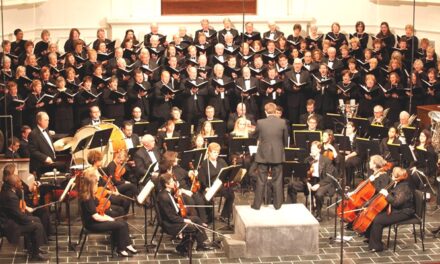The Eastern Music Festival is about half over, and the concerts – chamber and orchestral – are coming fast and furious. Members of the EMF faculty gathered together in Tew Recital Hall at UNC-G Monday evening for the third program of chamber music featuring four well-known composers.
Claude Debussy (France, 1862-1918) completed only three of his proposed Six Sonatas for Various Instruments before he died. His Sonata for Flute, Viola, and Harp was completed in 1915. What an unusual aural landscape the composer explored in this work!
The opening “Pastorale” is languid, with the three instruments entering and exiting the texture freely, more or less equally. The central “Interlude” (in the tempo of a Minuet), is a bit more rhythmic, but still with plenty of flexibility. The “Finale” (Allegro) sets the harp up in an accompaniment pattern, over which flute and viola exchange different ideas.
The trio – Les Roettges, flute, Victoria Chiang. viola (here as a Tannenbaum-Sternberger Distinguished Teaching Artist), and Anna-Kate Mackle, harp – wonderfully brought forth “an air of spontaneity – almost of improvisation,” which this work contains. The music had impeccable ensemble, no mean feat, as the score quixotically and frequently changes tempo and mood. They seemed to revel in the luxurious sonorities Debussy served up.
Jump back a hundred-plus years for the first of the Op. 9 String Trios (1797-98) by Ludwig van Beethoven (Germany, 1770-1827). This trio, “the most vigorous” of the three was performed Monday night by Mark Peskanov, violin (here as guest soloist Friday with the EFO), Chauncey Patterson, viola, and Julian Schwarz, cello. The musicians made the most out of dynamic contrasts and played with assertive energy.
What a delightful opening Beethoven brings to us, as the music seems to search for its proper footing. Each musician carved out a distinctive personality in the opening 60 seconds, a characteristic that carried through the entire four movements. The Adagio brings forth a texture dominated by the violin, but with some conversation, to be sure.
The Scherzo with a contrasting Trio is light-hearted fun. The finale was taken at a lickety-split speed, which brought the work to a rollicking conclusion, delighting the large crowd.
Giacomo Puccini (Italy, 1858-1924) is primarily known as a great composer of opera, but he did write a few compositions in other genres including a single-movement string quartet, “I Crisantemi”(The Chrysanthemums). The work (written in one night!) is a tribute to his friend Amadeo di Savoia, the Duke of Aosta, who died suddenly in 1890. The four string players were Randal Weiss and Joan Griffing, violins, Sarah Coté, viola, and Rebecca Zimmerman, cello.
This was a lovely reading, dark and beautiful. The score is dominated by 1st violin, and Weiss provided delicate leadership. Especially noteworthy was strong cello playing from Zimmerman. One could have asked for a more romantic reading, deeper and richer.
Felix Mendelssohn (Germany, 1809-47) wrote the Octet in E-flat when he was 16. The composer instructed the players to play in “symphonic orchestral style.” The musicians – Peskanov, John Fadial, Uli Speth and Jeffrey Multer, violins, Victoria Chiang and Patterson, violas, and Neal Cary and Beth Vanderborgh. cellos – did just that, playing with energy and skill.
1st violinist Peskanov announced that the work would be performed so that the 3rd movement Scherzo would precede the Andante slow movement. He said they would explain why later, but I suspect it was so there were not two fast movements (3rd and 4th movement) back-to-back.
The first movement is by far the longest movement and provided a showcase for Peskanov. The Scherzo, a tour-de-force piece with Mendelssohn’s trademark “elfin” music evident in every measure, is probably the best movement of the four.
The Andante is a tender, lyric movement, with the music material spread more evenly among the musicians. The Presto finale is wonderous, full of scurrying independent lines as each instrument enters in turn, frequently joining together in exciting climaxes.
Intonation was not perfect throughout, nor was ensemble, which wasn’t as tight as one expects from EMF players. Perhaps the ensemble could have used one more rehearsal.
However, the group did provide an encore by repeating the Scherzo, ending the evening in a swirl of energy.
See our calendar for upcoming EMF performances this month.











